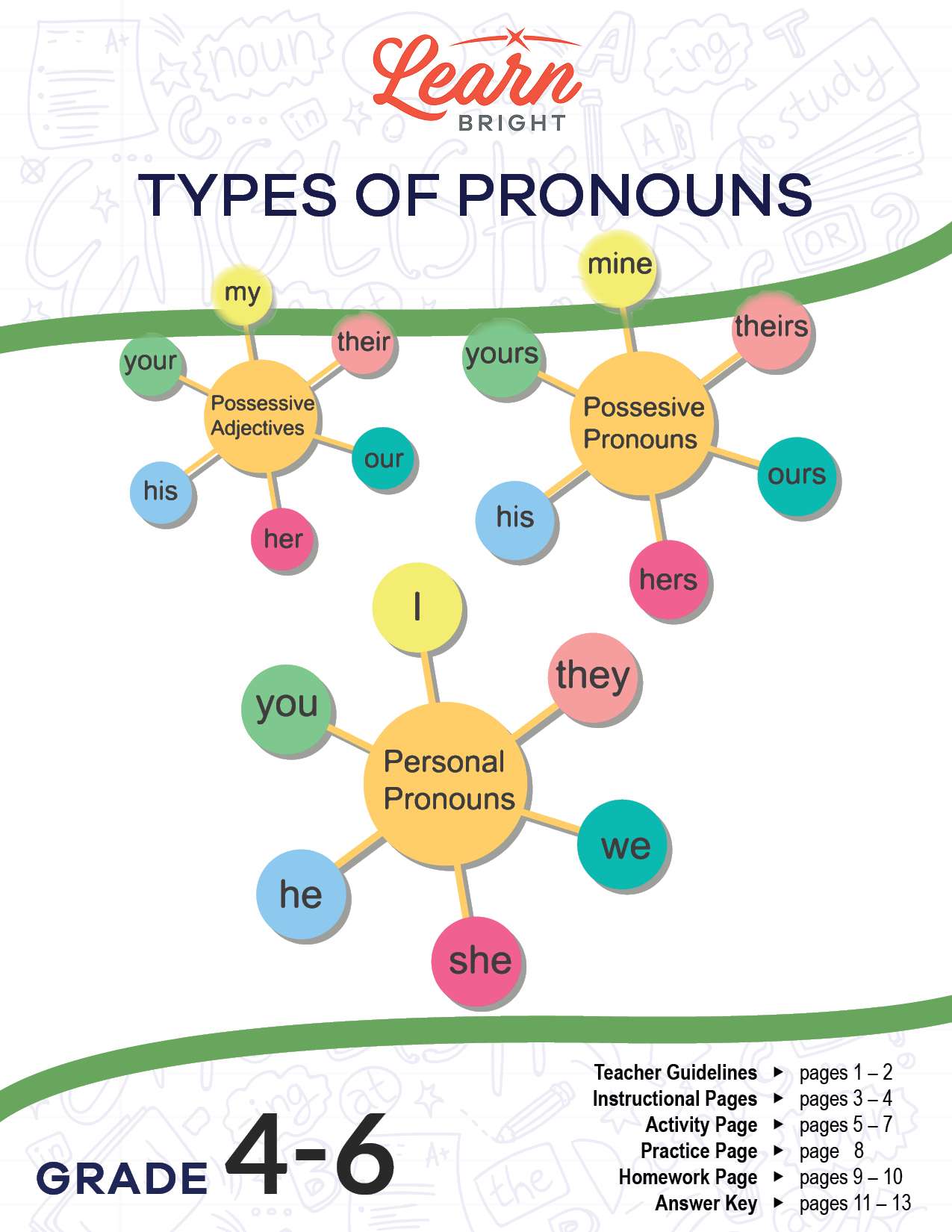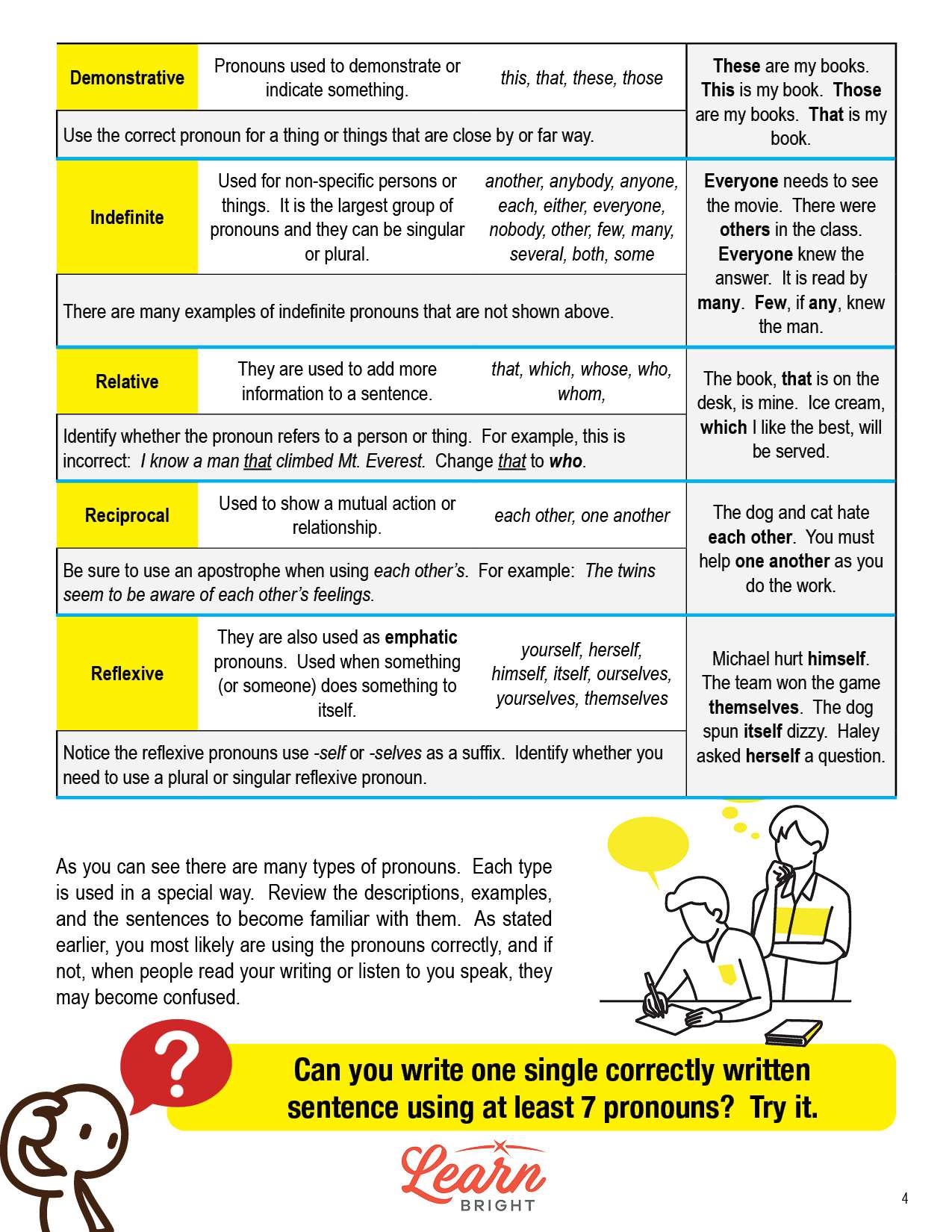Description
What our Types of Pronouns lesson plan includes
Lesson Objectives and Overview: Types of Pronouns introduces students to the different kinds of pronouns such as personal, possessive, indefinite, reflexive, and others. For all students, understanding the antecedent and using the correct matching pronoun is important. Students are familiar with most pronouns they use every day when they speak and write, but may not know there are many other words that can be identified as pronouns. At the end of the lesson, students will be able to define pronoun, recognize the eight types of pronouns, and use pronouns correctly. This lesson is for students in 4th grade, 5th grade, and 6th grade.
Classroom Procedure
Every lesson plan provides you with a classroom procedure page that outlines a step-by-step guide to follow. You do not have to follow the guide exactly. The guide helps you organize the lesson and details when to hand out worksheets. It also lists information in the green box that you might find useful. You will find the lesson objectives, state standards, and number of class sessions the lesson should take to complete in this area. In addition, it describes the supplies you will need as well as what and how you need to prepare beforehand. The only supplies you will need for this lesson are scissors and the handouts. To prepare for this lesson ahead of time, you can choose one of each type of pronoun for the lesson opening, gather scratch paper for the lesson closing, gather the supplies, and copy the handouts.
Options for Lesson
Included with this lesson is an “Options for Lesson” section that lists a number of suggestions for activities to add to the lesson or substitutions for the ones already in the lesson. The first few suggestions are related to the lesson activity. As a part of the activity, you can plan a Pronoun Tournament. You can also increase the number of pronouns used in the activity. Another suggested addition to the lesson is to have students write a story and use a certain number of pronouns of each type. You can also have students use their current reading content to identify pronouns and their types. Students can also research which type of pronoun is used most often in the English language. Finally, students can imagine themselves as one of the pronouns and write a creative story from the perspective of that pronoun.
Teacher Notes
The teacher notes page includes a paragraph with additional guidelines and things to think about as you begin to plan your lesson. This page also includes lines that you can use to add your own notes as you’re preparing for this lesson.
TYPES OF PRONOUNS LESSON PLAN CONTENT PAGES
Pronouns
The Types of Pronouns lesson plan includes two pages of content. The lesson begins with an example sentence that contains several pronouns (nine in total!). Students are likely familiar with pronouns such as I, he, we, and she. We call these personal pronouns, and they’re the most common type. They replace nouns representing people.
However, these are not the only type of pronoun. We use other types just as often, and it’s important to be able to identify them and use them in the correct way when speaking or writing. It would be very hard to avoid using pronouns.
While remembering the name of each type is not extremely important, you do need to be able to differentiate between them. Using them correctly will improve your writing and help people understand you!
Types of Pronouns
The next section of this lesson delves into eight different types of pronouns. The lesson includes a chart that shows the name of the type, a description, examples, and a sentence that uses that type of pronoun.
The first type are personal pronouns, which usually replace nouns that represent a person or people. Some examples are I, you, he, she, and it. It’s important to use the correct personal pronoun. Ask yourself whether it’s singular or plural, for a male, female, or both, and if you’re using it as first, second, or third person.
We use possessive pronouns as adjectives to show ownership and used before a noun. Possessives used on their own often end in –s. Examples include his, its, our, and their. When used on their own, we call them absolute possessive nouns.
The next type are interrogative pronouns, which we use for questions and replace nouns. Examples include who, whom, and whose. It’s sometimes difficult to know which noun it’s replacing. Some of these pronouns end with –ever.
We use demonstrative pronouns to demonstrate or indicate something. Examples include this, that, these, and those. We use indefinite pronouns for non-specific persons or things. This is the largest group of pronouns. Examples include another, anybody, anyone, and each.
We use relative pronouns to add more information to a sentence. Examples include that, which, and whose. To use these pronouns, you first need to identify whether the pronoun refers to a person or thing.
We use reciprocal pronouns to show a mutual action or relationship. Examples include each other and one another. It’s important to remember to use apostrophes as needed with these pronouns.
The final type are reflexive pronouns, which we also use as emphatic pronouns. We use them when something or someone does something to itself. Examples include yourself, herself, and himself.
There are many types of pronouns and they’re all used in different ways. It’s important to review their descriptions, examples, and sentences to familiarize yourself with them.
TYPES OF PRONOUNS LESSON PLAN WORKSHEETS
The Types of Pronouns lesson plan includes three worksheets: an activity worksheet, a practice worksheet, and a homework assignment. You can refer to the guide on the classroom procedure page to determine when to hand out each worksheet.
RAPID PRONOUNS ACTIVITY WORKSHEET
Students will work with a partner to play a Rapid Pronouns game. They will begin by cutting out the provided pronouns. Next, they will mix them up and place them upside down on their desk. When the teacher says to begin, one student will randomly turn over one of the pronouns and will create a sentence using that pronoun that is at least five words long. The students will take turns doing this until the teacher tells them to stop. They must make sure the sentences are correctly written with proper punctuation and grammar. Students will read their list of sentences to their partner to determine whether each sentence is complete and within the rules. The person with the most correct sentences wins!
PRONOUNS PRACTICE WORKSHEET
For the practice worksheet, students will complete three short exercises. The first asks them to review a list of pronouns, determine the type of each, and use them in sentences. The second asks them to circle the pronouns in ten sentences. The third asks them to place the eight types of pronouns in alphabetical order.
TYPES OF PRONOUNS HOMEWORK ASSIGNMENT
The homework assignment asks students to complete a few different exercises. They will first write an eight sentence story, where each sentence uses one pronoun from each pronoun type. Next, they will reach sentences and circle the correct pronouns (out of two choices) for each. Finally, they will write down an example of each of the eight types of pronouns.
Worksheet Answer Keys
This lesson plan includes answer keys for the practice worksheet and the homework assignment. No answer key is provided for the activity worksheet as students’ answers will vary. If you choose to administer the lesson pages to your students via PDF, you will need to save a new file that omits these pages. Otherwise, you can simply print out the applicable pages and keep these as reference for yourself when grading assignments.










